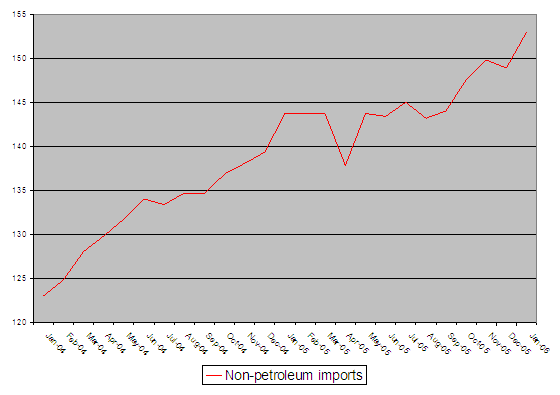Mike Mandel, Ricardo Hausmann and Federico Sturzenegger better be right (January trade data)
More on:
I sure hope that the US is exporting a lot of "intangibles" that don't show up in the trade data, and generating lots more intangible dark matter to offset all the external debt that the US is taking on.
Because the tangible deficit sure seems to be growing.
Exports are doing fine. January exports are up 12% y/y. Boeing had a good month. And corn and soybeans seem to be flowing out of the mouth of the Mississippi to world markets again.
The argument that the trade deficit is growing because the world isn't growing doesn't hold water. Right now, strong global growth is propelling strong US export growth. Even with a stronger dollar.
But 12% y/y export growth doesn't cut it if imports are up by about 16% y/y - and non-oil imports are up 11.2% y/y.
The real story in my book is the continued acceleration in non-oil imports.
Consider the trend in non-oil goods imports
July: $116.2b (roughly the same as in the first half of 2005)
August: $117.3
September: $120.2
October: $122.3
November: $121.5
December $125.35
January: $130.1b
You don't need to be a rocket scientist to see something of an acceleration in US imports of "tangible" goods - even leaving out oil. Just look at the graph showing the recent trend in non-oil imports (goods and services, a bit different than the goods only data above) below the fold.

Annualized, the $68.5b monthly goods and services deficit in January works out to $820 b - or $100 b or so more than the 2005 deficit. I expect the strong(er) dollar will exert a drag on US export growth, which I expect to slow a bit. And barring a broader slowdown in the US economy, I don't see much that will lead to a sharp slowdown in import growth. Toyota looks poised to have a very, very good year. So I would expect the annual trade deficit in 2006 to widen just a bit, to maybe $840-850b.
Throw in a transfers deficit of $80b and an income deficit of $70b - remember, the US has to pay interest on the $820b in net debt it took on in 2005, and the interest rate on the existing US stock of short-term debt is rising as well - and a current account deficit of close to $1 trillion is a very serious possibility.
I honestly am not putting that number out just for effect; it is the number that is popping out of my spreadsheets.
One last set of points.
The y/y increase in US imports from Asian countries not named China was 7.5%, roughly in line with the growth in US nominal GDP.
The y/y increase in US imports from old decrepit Europe (otherwise known as the Eurozone) was 12.9%. I am not quite sure what is going on there ... other than rapid US consumption growth is rising all boats. And that some parts of old Europe are pretty competitive in certain markets.
The y/y increase in US imports from China was a tad under 20%.
And the y/y increase in US imports from the Pacific Rim (including China) was 12.7%.
So long as overall US imports are growing faster than nominal US GDP, and are rising as a share of US GDP, I don't think it makes sense to talk about how China is just taking market share away from other Asian economies. US imports from the Pacific Rim are set to rise from 3.7% of US GDP in 2001 to 4.8% in 2006.
If you are smart, you would know that using 2001 (tech bust, recession, 9.11) as the base year massages this number, and distorts the picture just a bit.
But my sleight of hand is no more deceptive than those (hired hands of the US China Business forum) who have used the 2000 peak in US imports from the Pacific Rim (4.25%) as the base for their argument that China is just taking market share away from other Asian economies.
I think it makes sense to use the average of 2000-01 as a base - which puts US imports from the Pacific Rim at about 4% of GDP.
The China is taking market share from the rest of Asia story worked through 2003 - but not since. Overall US imports from the Pacific Rim have been growing faster than US GDP since then.
Then again, so have US imports from pretty much every part of the globe.
There hasn't been any landing, hard or soft, to date. The biggest import market in the world is sucking in goods and services from everyone, propelling global growth.
With massive imbalances.
But, as Mark Gilbert has pointed out, in 2005 the bond market concluded that worrying about imbalances was something that other people should do, just like worrying about credit risk was something best left to those not actually in the market.
That has consequences. Without any market pressure to adjust, so far, the world has opted not to.
More on:
 Online Store
Online Store
